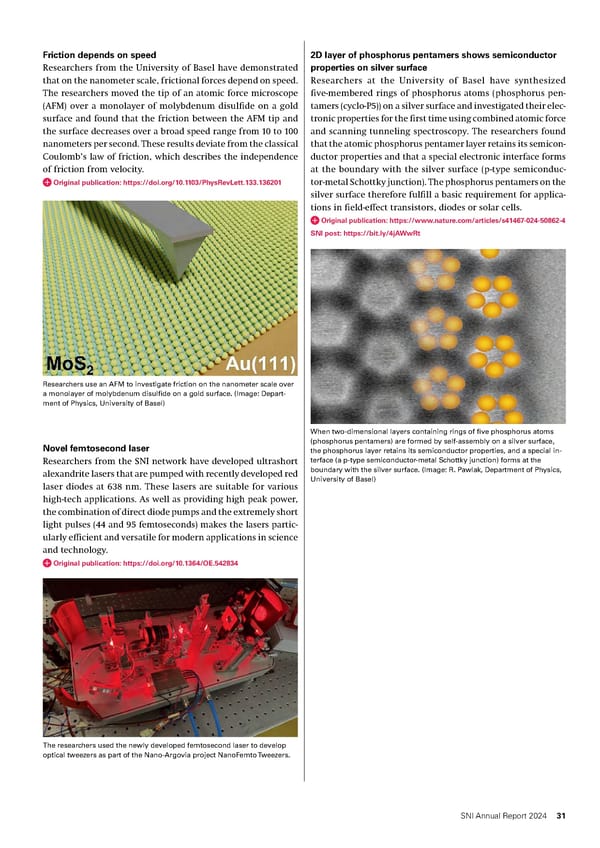Friction depends on speed 2D layer of phosphorus pentamers shows semiconductor Researchers from the University of Basel have demonstrated properties on silver surface that on the nanometer scale, frictional forces depend on speed. Researchers at the University of Basel have synthesized The researchers moved the tip of an atomic force microscope five-membered rings of phosphorus atoms (phosphorus pen- (AFM) over a monolayer of molybdenum disulfide on a gold tamers (cyclo-P5)) on a silver surface and investigated their elec- surface and found that the friction between the AFM tip and tronic properties for the first time using combined atomic force the surface decreases over a broad speed range from 10 to 100 and scanning tunneling spectroscopy. The researchers found nanometers per second. These results deviate from the classical that the atomic phosphorus pentamer layer retains its semicon- Coulomb’s law of friction, which describes the independence ductor properties and that a special electronic interface forms of friction from velocity. at the boundary with the silver surface (p-type semiconduc- Original publication: https://doi.org/10.1103/PhysRevLett.133.136201 tor-metal Schottky junction). The phosphorus pentamers on the silver surface therefore fulfill a basic requirement for applica- tions in field-effect transistors, diodes or solar cells. Original publication: https://www.nature.com/articles/s41467-024-50862-4 SNI post: https://bit.ly/4jAWwRt Researchers use an AFM to investigate friction on the nanometer scale over a monolayer of molybdenum disulfide on a gold surface. (Image: Depart- ment of Physics, University of Basel) When two-dimensional layers containing rings of five phosphorus atoms Novel femtosecond laser (phosphorus pentamers) are formed by self-assembly on a silver surface, the phosphorus layer retains its semiconductor properties, and a special in- Researchers from the SNI network have developed ultrashort terface (a p-type semiconductor-metal Schottky junction) forms at the alexandrite lasers that are pumped with recently developed red boundary with the silver surface. (Image: R. Pawlak, Department of Physics, laser diodes at 638 nm. These lasers are suitable for various University of Basel) high-tech applications. As well as providing high peak power, the combination of direct diode pumps and the extremely short light pulses (44 and 95 femtoseconds) makes the lasers partic- ularly efÏcient and versatile for modern applications in science and technology. Original publication: https://doi.org/10.1364/OE.542834 The researchers used the newly developed femtosecond laser to develop optical tweezers as part of the Nano-Argovia project NanoFemto Tweezers. SNI Annual Report 2024 31
 Annual Report 2024 - Swiss Nanoscience Institute Page 30 Page 32
Annual Report 2024 - Swiss Nanoscience Institute Page 30 Page 32